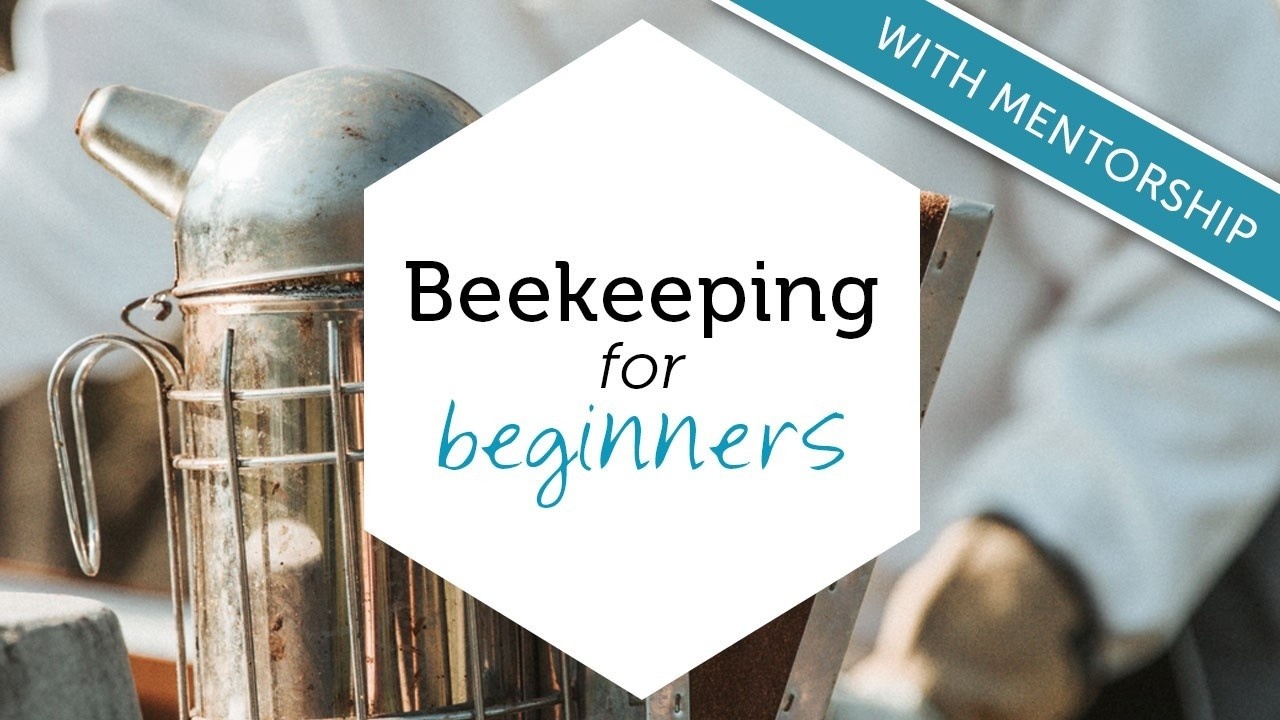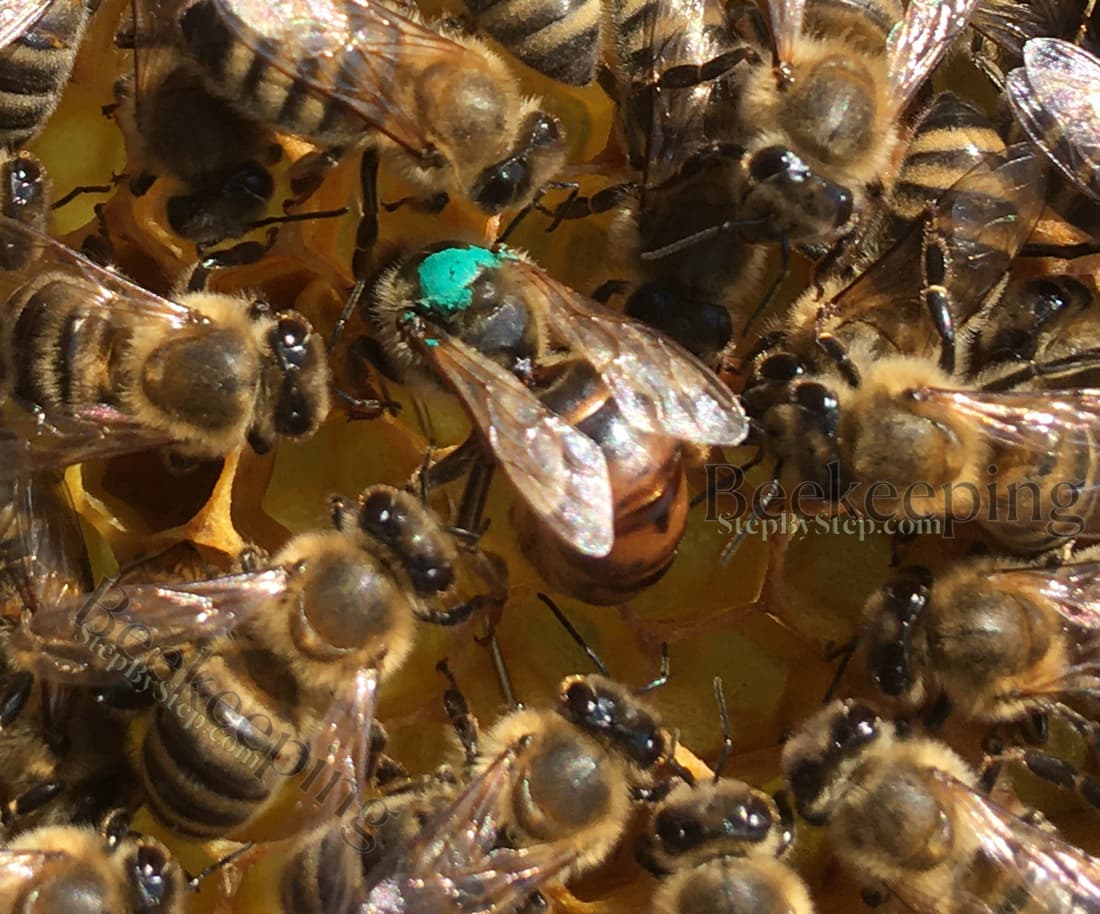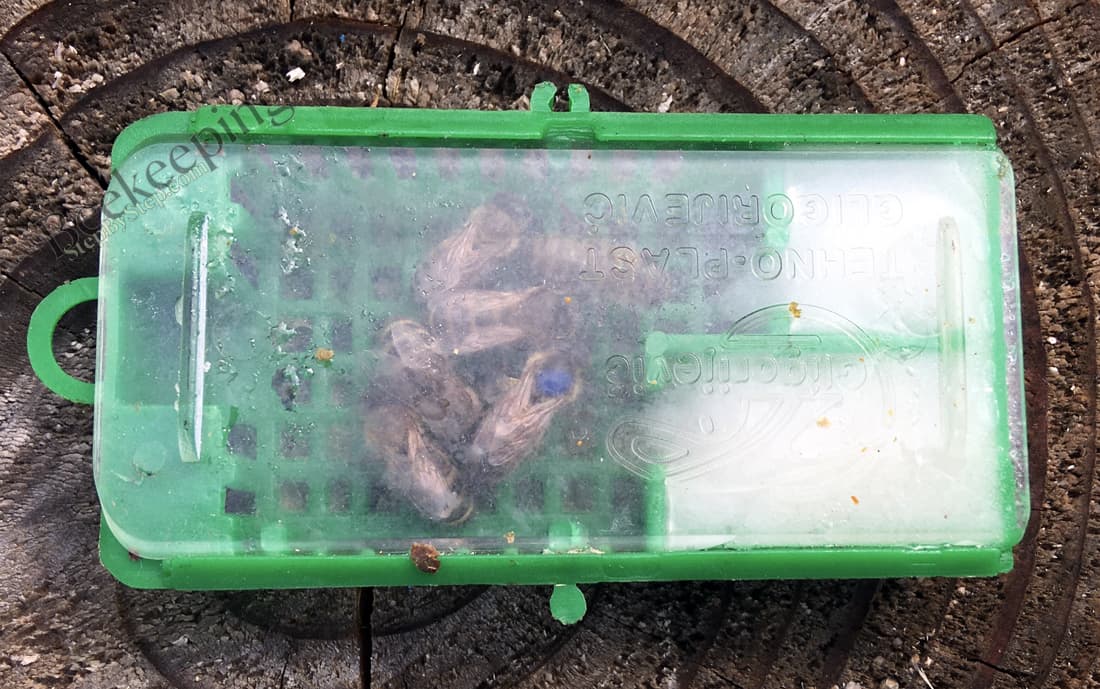It is often required to replace the queen bee because of her bad genes, years, lesser egg laying or some other reason. This has to be done really carefully and in a precise way because the bees recognize their own queen and tend to kill any other.
If the colony has gotten very weak because of the bad queen, there is no point in changing the queen but rather combining it with a strong or relatively strong colony, especially at the end of the summer and in fall.
Instructions for combining two colonies: Combining Two Colonies.
Advertisement :

Beekeeping for Beginners
Everything you need to know!
This is a full beekeeping course for beginners.
Why should you replace the queen bee
Replacing the queen bee every or every other year
Queen's fertility is at its peak during the first and the beginning of her second year and after that it slowly decreases. This is why beekeepers often don't keep queens older than two years; instead, they replace them with new young queens every or every other year.

If the bee colony has a new young queen there is a smaller chance that she will swarm. This is the reason why many beekeepers use yearly replacement of the queen as a precaution for the swarming.
This kind of replacing is good to do after the main spring honey flow (when there is plenty of food in the brood box) or during some slow honey flow.
If there is something wrong with the queen bee
If there is something wrong with the queen, she should be replaced.

Most common reasons for replacing the queen bee :
![]() The old queen bee is getting exhausted
The old queen bee is getting exhausted
![]() The queen doesn't lay as many eggs as she used to
The queen doesn't lay as many eggs as she used to
![]() She is not properly mated
She is not properly mated
![]() Chalkbrood
Chalkbrood
![]() Drone laying queen - queen that only lays unfertilized eggs from which the drones will hatch
Drone laying queen - queen that only lays unfertilized eggs from which the drones will hatch
![]() Angry bees - if the honey bee colony is constantly too aggressive and hard to work with...
Angry bees - if the honey bee colony is constantly too aggressive and hard to work with...
For more information read - Problems With The Queen.
Removing the queen bee from the beehive
In order to replace the queen, first you should remove the old queen from the beehive.
One day before putting in the new queen or queen cell, you have to find the old queen and pinch her.
Instructions for finding the queen - How To Find The Queen.
This isn't a pleasant task, especially for a beginner beekeeper, but, often, it is the best solution to save the beehive.
Different possibilities when replacing the queen bee
You have removed the unwanted queen from the beehive and now you need to provide the colony with a new one.
This can be done by:
1Adding the mated queen
2Adding the closed queen cell
3Letting the bees make the new queen by themselves
4One beehive can make queen cells for all other beehives (if the beekeeper is replacing queens in more than one beehive at the same time)
Pay attention, in order for the young queen bee to mate, there should be drones. There are not enough drones at the beginning of spring and in fall.

The best queens are those that develop during the good honey flow.
Replacing the queen with a mated queen bee - steps
Mated queen is added one day after removing the old queen from the beehive.

By adding mated queen bee, the colony stagnates the least because there is the shortest period without laying new eggs - only two or three days. Mated queen will start laying eggs as soon as she is released from her cage.
If the bee colony is weak, this is the most advisable way to change a queen.
Mated queens can be produced on the apiary but that task is difficult for a beginner beekeeper. The beekeeper can buy a mated queen, best from the local beekeeper who raises them.
In early spring and fall it is hard to find queens to buy.
Replacing the queen with a mated queen - step by step:
1☀️ First day
Remove the old queen from the beehive.
2☀️ Next day
Add a mated queen in a cage - instructions: New Queen Introduction.
Replacing the queen bee with a closed queen cell
Conditions:
![]() There must be drones for mating
There must be drones for mating
![]() You have to have closed mature queen cells in some other beehive on the apiary
You have to have closed mature queen cells in some other beehive on the apiary
The new queen bee usually inherits most of the features from the queen which laid the egg. So you shouldn't use queen cell from the beehive that has bad genes, in other words, that has features that you don't like.
Closed queen cell is added one day after removing the old queen from the beehive.
If there are some hives with good queen cells on the apiary (swarming, supersedure, emergency queen cells), you can choose one or two nice, mature queen cells and put them in the beehive that needs a new queen.
Learn more about three kinds of queen cells here: Three Kinds Of Queen Cells.
If the queen mates successfully she will most likely start laying eggs about 15 to 20 days after adding the queen cell. This period can extend due to bad weather or some other reason.
If the queen is replaced in this manner in a weak colony, full attention and care should be paid to that colony in order for it to develop as quickly as possible.
Replacing the queen bee with a closed queen cell - step by step:
1☀️ Day 1:
Remove the queen from the beehive.
2☀️ Next day:
Add the closed queen cell - instructions: Queen Cell Introduction.
Let the bees make a new queen on their own
Condition:
![]() There must be eggs and/or young worker larvae up to 3 days old in the beehive
There must be eggs and/or young worker larvae up to 3 days old in the beehive
![]() There must be drones for mating
There must be drones for mating
New queen's genetics will be similar as the old queen's which is why this method is not desirable to do if you want to change features of that colony (for example angry bees).
If a new queen or queen cell is not put in the hive after removing the unwanted queen, the bees will start making the queen cells on their own.
In order for the bees to build queen cell there needs to be young brood (eggs and/or larvae up to 3 days old) in the beehive.
With this method, from the queen's removal from the hive, up until the young queen emerges, mates and starts laying eggs, 20-30 days will pass.
Because of the long period without the brood, this method of changing the queens is not advisable for weak hives. However, if this method is done anyway, special attention and care should be paid to the weak colony so it can quickly grow stronger.
Disadvantages of this method:
![]() It has the longest period without brood which means the number of bees will decrease in the hive
It has the longest period without brood which means the number of bees will decrease in the hive
![]() If the old queen had bad genes, most of those genes will pass on to the new young queen
If the old queen had bad genes, most of those genes will pass on to the new young queen
Let the bees make their own queen - step by step:
1☀️ First day:
Remove the queen from the hive.
2☀️ Fourth day after queen removal:
Destroy the bad queen cells - instructions: Let The Bees Make The Queen On Their Own.
One beehive can make queen cells for all other beehives
Conditions:
![]() Young queens will only mate if there are drones in nature.
Young queens will only mate if there are drones in nature.
![]() There must be eggs and/or young larvae up to 3 days old in the hive which make queen cells.
There must be eggs and/or young larvae up to 3 days old in the hive which make queen cells.
If you are replacing queens in multiple beehives, instead of buying mated queens or waiting for each hive to make its own queen, and you don't have any queen cells that you can add to the hives, you can choose one colony with good features and that one can make queen cells for all the other colonies.
This way you will pass the genes from the best honey bee colony onto other colonies, and the queens from the other hives will continue to lay eggs up until the queen cells are ready for transfer.
Step by step:
1Making the queen cells:
☀️ First day:
1Choose the colony with the best features - calmness, strength, productivity...
2Remove the queen from that colony
☀️ 4. day after queen removal:
3Follow the instructions from - Let The Bees Make Their Own Queen, but don't wait for the queens to hatch. Those queen cells that the colony produces, you will use to put in other bee colonies where you are replacing the queen.
2☀️ After 6 days (Ten days after queen removal):
1Remove the queens from all the beehives where the queen should be replaced
3☀️ Next day (11. day from the beginning):
1For every beehive where you want to replace the queen and where you removed the queen the previous day, follow the instructions from - Queen Cell Introduction. Pick up the queen cells from the first beehive from which you removed the queen and which made emergency queen cells.
2Leave one or two nice big queen cells in the hive from which you took the queen cells for other hives
If there is no good honey flow in the nature, the beehive, from which you are taking queen cells, should be fed. The beehive is fed every night with 600g of sugar water in 1 to 1 ratio until the queen cells are closed (about 9 days from egg laying).